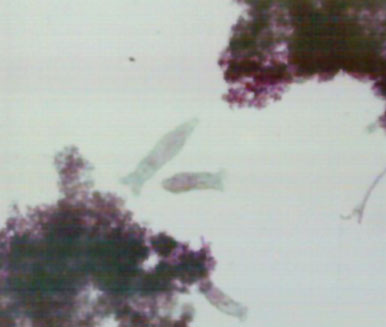The air conditioning at my office wasn't working this morning when I arrived -- it was 20 degrees warmer in the building than outside, so I left notes on the door and came home to work. I spent most of the day exploring a new digital microscope I got: a  Digiscope 150. I'm exploring it with the idea of potentially using it for teaching. And I thought my boys would enjoy playing with it too.
Digiscope 150. I'm exploring it with the idea of potentially using it for teaching. And I thought my boys would enjoy playing with it too.
It markets itself as better than the Intel QX3, which was similiar, but supposedly had plastic lenses, whereas the Digiscope has glass lenses. The software it comes with is for MacOS 9x only -- no MacOS X support. (Or Windows, of course). I didn't really want to use the software it came with anyway, which was reviewed as being excessively childish. I hoped to use it with  ImageJ. I tried
ImageJ. I tried  macam, but it wasn't supported. I found a driver that did work by IOXperts, but they wanted $19.95. The driver that worked, was actually for a different scope: the
macam, but it wasn't supported. I found a driver that did work by IOXperts, but they wanted $19.95. The driver that worked, was actually for a different scope: the  Scalar USB Microscope, so I uninstalled the IOXpert driver and checked the Scalar site and found that they had software and drivers for MacOS X. I downloaded and installed them and they worked OK. They don't work particularly well with ImageJ, unfortunately, but the Scalar capture software is acceptable, with the exception that it can't do measurement. I probably should have bought their product to begin with (except that it costs $700 and I was looking for something in the $100 range).
Scalar USB Microscope, so I uninstalled the IOXpert driver and checked the Scalar site and found that they had software and drivers for MacOS X. I downloaded and installed them and they worked OK. They don't work particularly well with ImageJ, unfortunately, but the Scalar capture software is acceptable, with the exception that it can't do measurement. I probably should have bought their product to begin with (except that it costs $700 and I was looking for something in the $100 range).
The digiscope doesn't take great pictures, but they might be good enough. Here are some rotifers I found by siphoning up a little gunk off the bottom of the turtle's tank.

You can see the gross structure of the rotifer, though nowhere near enough detail to do much identification. I tried identifying rotifers when I was in graduate school and found that you often had to have several specimens so you could see external structure and then details of their internal structure as well. I didn't try to identify this one.
You can also take  videos, albeit rather small and grainy. It's not a bad video of rotifer movement, though.
videos, albeit rather small and grainy. It's not a bad video of rotifer movement, though.
It isn't a very high quality CCD and the "optics" appear to have a lot of chromatic abberation. Moreover, the one I got has a defect with the ocular lens the camera uses. I was hoping for something with high enough resolution that you could see Oscilatoria with it. The Digiscope 300 has higher power and I think one would need to have that for any hope of seeing something so small. This one might be good enough with soil invertebrates though, which is the other use I'm want to try out.